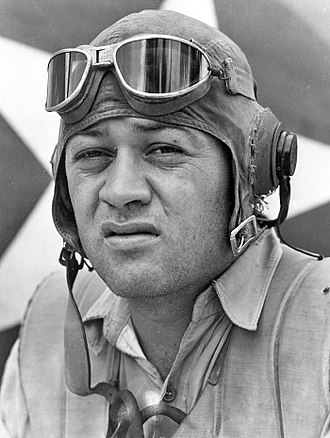Pappy Boyington

Gregory “Pappy” Boyington (December 4, 1912 – January 11, 1988) was an American combat pilot who was a United States Marine Corps fighter ace during World War II. He received the Medal of Honor and the Navy Cross. A Marine aviator with the Pacific fleet in 1941, Boyington joined the “Flying Tigers” (1st American Volunteer Group) of the Republic of China Air Force and saw combat in Burma in late 1941 and 1942 during the military conflict between China and Japan.
In September 1942, Boyington rejoined the Marine Corps. In early 1943, he deployed to the South Pacific and began flying combat missions in the F4U Corsair fighter. In September 1943, he took command of Marine fighter squadron VMF-214 (“Black Sheep”). In January 1944, Boyington, outnumbered by Japanese “Zero” planes, was shot down into the Pacific Ocean after downing one of the enemy planes. He was captured by a Japanese submarine crew and was held as a prisoner of war for more than a year and a half. He was released shortly after the surrender of Japan. The television series Baa Baa Black Sheep was inspired by Boyington and his men in the “Black Sheep” squadron. It ran for two seasons in the late 1970s.
Born on December 4, 1912, in Coeur d’Alene, Idaho,[1][2] he moved with his family to the logging town of St. Maries at age three and lived there until age twelve.[3] He then lived in Tacoma, Washington, where he was a wrestler at Lincoln High School.[1] He took his first flight at St. Maries when he was six years old, with Clyde Pangborn,[4] who later became the first pilot to fly over the Pacific Ocean non-stop.[1]
After graduation from high school in 1930, Boyington attended the University of Washington in Seattle, where he was a member of the Army ROTC and joined the Lambda Chi Alpha fraternity.[1] He was on the Husky wrestling and swimming teams, and for a time he held the Pacific Northwest Intercollegiate middleweight wrestling title. He spent his summers working in Washington in a mining camp and at a logging camp and with the Coeur d’Alene Fire Protective Association in road construction. He graduated in 1934 with a bachelor’s degree in aeronautical engineering. Boyington married shortly after graduation and worked as a draftsman and engineer for Boeing in Seattle.[1]
Military career
Boyington began his military training in college as a member of Army ROTC and became a cadet captain. He was commissioned a second lieutenant in the U.S. Army Coast Artillery Reserve in June 1934, and then served two months of active duty with the 630th Coast Artillery at Fort Worden, Washington.[citation needed] In the spring of 1935, he applied for flight training under the Aviation Cadet Act, but he discovered that it excluded married men.[5] Boyington had grown up as Gregory Hallenbeck, and assumed his stepfather, Ellsworth J. Hallenbeck, was his father.[2][6][7] When he obtained a copy of his birth certificate, he learned that his father was actually Charles Boyington, a dentist, and that his parents had divorced when he was an infant.[3] As there was no record of any Gregory Boyington ever being married, he enrolled as a U.S. Marine Corps aviation cadet using that name.[8]
United States Marine Corps
On June 13, 1935, he transferred to the U.S. Marine Corps Reserve. He returned to inactive duty on July 16.[1] On February 18, 1936, Boyington accepted an appointment as an aviation cadet in the Marine Corps Reserve. He was assigned to Naval Air Station Pensacola for flight training. Boyington was designated a Naval Aviator on March 11, 1937, then transferred to Marine Corps Base Quantico for duty with Aircraft One, Fleet Marine Force. He was discharged from the Marine Corps Reserve on July 1, 1937, in order to accept a second lieutenant’s commission in the Marine Corps the following day.[1] Boyington attended The Basic School in Philadelphia from July 1938 to January 1939. On completion of the course, he was assigned to the 2nd Marine Aircraft Group at the San Diego Naval Air Station. He took part in fleet problems off the aircraft carriers USS Lexington and USS Yorktown. Promoted to first lieutenant on November 4, 1940, Boyington returned to Pensacola as an instructor in December.[1]
